The Mini Spray Bottles Market is estimated to be valued at USD 2.0 billion in 2025 and is projected to reach USD 3.5 billion by 2035, registering a compound annual growth rate (CAGR) of 5.8% over the forecast period.
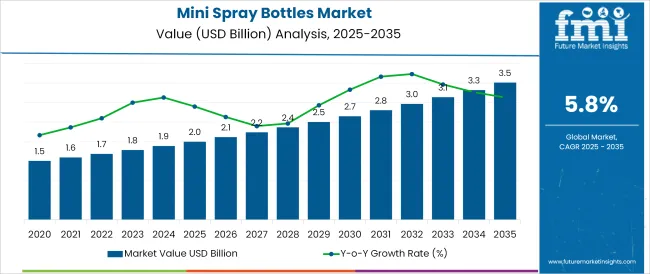
The mini spray bottles market is witnessing consistent demand, shaped by increasing consumer interest in portability, hygiene, and travel-friendly packaging formats. Rising use of sprays across personal care, pharmaceuticals, and homecare categories has accelerated the need for compact dispensing solutions that offer convenience without compromising function.
Heightened focus on hygiene, particularly post-pandemic, has reinforced consumer reliance on miniaturized packaging for disinfectants, sanitizers, and facial mists. Meanwhile, sustainability trends have prompted manufacturers to invest in recyclable and refillable formats, especially within plastic-based variants.
The availability of advanced dispensing mechanisms and customizable closures has enhanced market adaptability across end-use sectors. Regulatory and airline travel constraints on liquid volume have further normalized sub-5ml and small-capacity packaging, particularly in skincare and health applications. With brand differentiation hinging on functionality and visual appeal, mini spray bottles continue to offer versatile, scalable solutions aligned with evolving consumer preferences and regulatory standards.
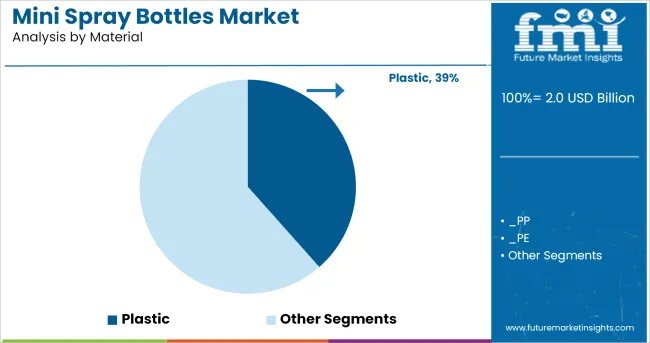
It is observed that the plastic sub-segment constitutes 38.50% of the overall market within the material category, making it the most preferred substrate. This is due to plastic’s lightweight nature, design flexibility, and cost-efficiency in mass production. Its compatibility with a range of closure types and liquid formulations has ensured wide applicability.
Additionally, advances in recyclable and post-consumer resin (PCR) materials have mitigated sustainability concerns, allowing brands to balance performance with eco-conscious objectives. Plastic's ability to withstand varying chemical compositions without leakage or degradation has also contributed to its dominance.
The ease of molding and availability in multiple shapes and sizes have further supported its adoption in cosmetics, sanitization, and pharmaceutical applications, reinforcing its leading position in the material segment.
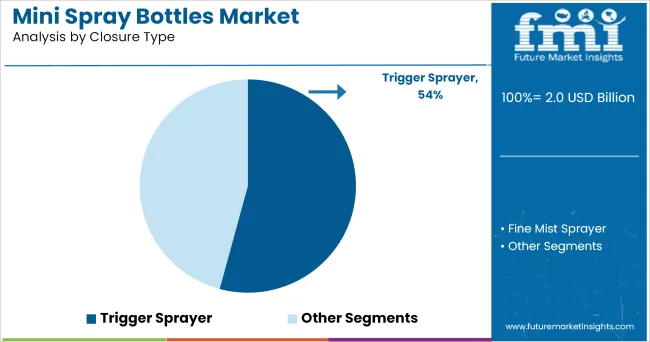
The trigger sprayer segment holds a 54.20% revenue share within the closure type category, marking it as the leading choice for mini spray bottles. This preference is linked to its ergonomic design, user control, and efficient liquid distribution. It allows precise spraying and reduced product waste, making it suitable for both high-viscosity and low-viscosity formulations.
Brands favor this closure type for personal care and cleaning applications due to its durability and secure locking features. The trigger mechanism supports continuous spraying with minimal hand fatigue, which is particularly beneficial in high-frequency use scenarios.
Its adaptability across refillable and single-use formats has also enhanced its utility. This blend of user convenience, functional performance, and cross-industry versatility has solidified the trigger sprayer's leadership in the closure segment.
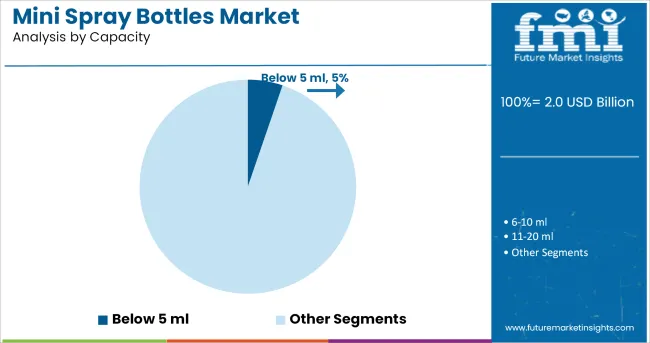
The below 5 ml segment contributes 5.20% to the total market within the capacity category, emerging as a key niche due to rising demand for ultra-portable packaging. Although it represents a smaller share, its relevance is growing in contexts where dosage control, sample distribution, and travel compliance are critical.
This capacity format aligns with evolving consumer behaviors centered on minimalism and on-the-go usage, especially in skincare and fragrance segments. Brands utilize it for trial packs, promotional giveaways, and daily-use formulations where space-saving and spill-proof properties are essential.
Its lower material usage also appeals to sustainability-focused packaging initiatives. The continued need for compact, compliant, and single-serve packaging solutions is expected to support steady growth in this segment, despite its current smaller revenue footprint.
The spray bottles are the bottles that can mist the fluids and are used to dispense the fluid using a valve. The spray bottles have wide application in food & beverage, cosmetic, pharmaceutical, household, and other industries. The mini spray bottles are the small bottles used to dispense the cool chemicals, cleaners, and other content.
The mini spray bottles are easy to carry and convenient to use. Also, the mini spray bottles are cost-effective and can be used by consumers who want the product in small quantities. The mini spray bottles used in the cosmetic and pharmaceutical industry are the best suitable spray bottles for travel purposes as they do not contain heavyweight and are easy to use.
The small size helps in reducing the cost this also attracts the middle or low middle-class people as they can also purchase it which increases the sales of mini spray bottles among the end-use industries. The spray available in mini bottles increases the sales of the product as people do carry out trial and error methods on the new product by purchasing the smaller quantity of the product which helps them to test the product at a lower cost.
This increases the demand for mini spray bottles especially by the end-use industries launching their new range of products. Overall, the growth of the mini spray bottles market is anticipated to propel during the forecast period due to its attractive benefits and increasing demand by the end-use industries.
The major factor leading the mini spray bottles is the increasing demand for mini spray bottles by the major end-use industries such as cosmetic & personal care, food & beverage, pharmaceuticals, and other industries. The cosmetic & personal care industry consists of segments such as skincare, haircare, makeup, fragrance, and hygiene products.
The mini spray bottles in the cosmetic industry are used for hairspray, skincare sprays, and perfumes. According to L'Oréal, in 2024 more than 70% of the cosmetic market is held by the skincare segment followed by the haircare, and fragrance segment. These segments drive the sales for mini spray bottles in the cosmetic & personal care industries.
Moreover, the increasing homemade food items which require food colour such as cakes, ice-creams, and other items augment the sales of mini spray bottles in the food & beverage industries.
The rising concern about health and safety boost the need for hygiene & safety sprays which supplement the sales for mini spray bottles as consumer prefer small bottles while travelling as it contains low weight which is easy to carry. Overall, the demand for mini spray bottles is projected to show a rise in the coming years.
The need for customization is increasing in every industry to attract consumers as well as to meet the surging demand for the same. The mini spray bottles can be customized as per the requirement and also the mini spray bottles are available with different types of closures. This factor generates market growth opportunities for the mini spray bottles.
Also, the increasing trend of DIY’s gives rise to sprays bottles which are available in small quantities. This widens the growth opportunity for the mini spray bottles. Thus, the customization feature offers a wide growth opportunity to the mini spray bottles market.
Majorly the mini spray bottles are made from different types of plastic materials so the shortage of plastic in future can hamper the market growth of the mini spray bottles market.
Also, the manufacturer needs to focus on a plastic material that is not harmful to nature which may result in a high cost for procuring the eco-friendly material. This may hinder the growth of the mini spray bottles market due to the price rise.
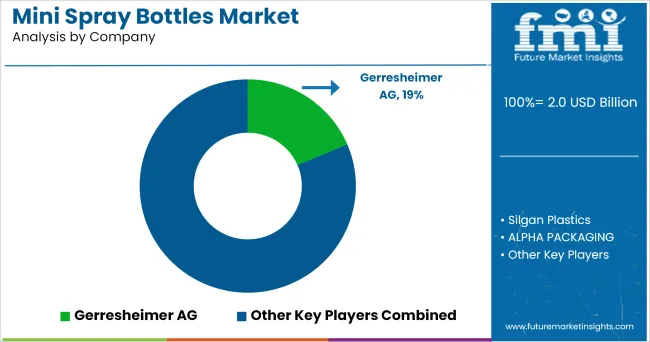
The global key players for Mini Spray Bottles are
Some of the Asia Pacific players includes
Major players operating in manufacturing mini spray bottles are focusing on launching new products to expand their product portfolio and to serve the various emerging demand from the end-use industries. Also, the key players are trying to focus on the sustainability trend by developing the sustainable product by partnering/collaborating with some associations or companies.
According to Cosmetic Europe, the personal care association the majority of Europe’s population uses cosmetic & personal care products on an everyday basis to protect their health and enhance & boost their well-being and self-esteem. The usage of deodorants in the United Kingdom is more, is 94% of women & 87% of men use the deodorants.
This increasing use of cosmetic & personal care products by the consumers in the United Kingdom give rise to the sales of mini spray bottles which is easy to carry without experiencing the heavyweight while carrying. Thus, the rising use of cosmetic & personal care products on the daily basis in the United Kingdom bolster the demand for mini spray bottles.
India has a large population that majorly consist of middle income and low middle-income group people. The mini spray bottles which cost lower than the large bottles as well as available in small portion attracts the middle & low middle-income group people which increasing the sales of spray products packed in mini bottles.
Also, the Indian population are fond of trying newly launched products, so the new spray product available in mini spray bottles catches the attention of such consumers as they can test the product at a lower cost. Thus, the Indian market is projected to offer growth opportunities for the mini spray bottles market.
The global mini spray bottles market is estimated to be valued at USD 2.0 billion in 2025.
The market size for the mini spray bottles market is projected to reach USD 3.5 billion by 2035.
The mini spray bottles market is expected to grow at a 5.8% CAGR between 2025 and 2035.
The key product types in mini spray bottles market are plastic, pp, pe, pvc, PET and glass.
In terms of closure type, trigger sprayer segment to command 54.2% share in the mini spray bottles market in 2025.






Our Research Products

The "Full Research Suite" delivers actionable market intel, deep dives on markets or technologies, so clients act faster, cut risk, and unlock growth.

The Leaderboard benchmarks and ranks top vendors, classifying them as Established Leaders, Leading Challengers, or Disruptors & Challengers.

Locates where complements amplify value and substitutes erode it, forecasting net impact by horizon

We deliver granular, decision-grade intel: market sizing, 5-year forecasts, pricing, adoption, usage, revenue, and operational KPIs—plus competitor tracking, regulation, and value chains—across 60 countries broadly.

Spot the shifts before they hit your P&L. We track inflection points, adoption curves, pricing moves, and ecosystem plays to show where demand is heading, why it is changing, and what to do next across high-growth markets and disruptive tech

Real-time reads of user behavior. We track shifting priorities, perceptions of today’s and next-gen services, and provider experience, then pace how fast tech moves from trial to adoption, blending buyer, consumer, and channel inputs with social signals (#WhySwitch, #UX).

Partner with our analyst team to build a custom report designed around your business priorities. From analysing market trends to assessing competitors or crafting bespoke datasets, we tailor insights to your needs.
Supplier Intelligence
Discovery & Profiling
Capacity & Footprint
Performance & Risk
Compliance & Governance
Commercial Readiness
Who Supplies Whom
Scorecards & Shortlists
Playbooks & Docs
Category Intelligence
Definition & Scope
Demand & Use Cases
Cost Drivers
Market Structure
Supply Chain Map
Trade & Policy
Operating Norms
Deliverables
Buyer Intelligence
Account Basics
Spend & Scope
Procurement Model
Vendor Requirements
Terms & Policies
Entry Strategy
Pain Points & Triggers
Outputs
Pricing Analysis
Benchmarks
Trends
Should-Cost
Indexation
Landed Cost
Commercial Terms
Deliverables
Brand Analysis
Positioning & Value Prop
Share & Presence
Customer Evidence
Go-to-Market
Digital & Reputation
Compliance & Trust
KPIs & Gaps
Outputs
Full Research Suite comprises of:
Market outlook & trends analysis
Interviews & case studies
Strategic recommendations
Vendor profiles & capabilities analysis
5-year forecasts
8 regions and 60+ country-level data splits
Market segment data splits
12 months of continuous data updates
DELIVERED AS:
PDF EXCEL ONLINE
Miniplate for Bone Fixation Market Size and Share Forecast Outlook 2025 to 2035
Miniature Electrochemical CO Sensor Market Size and Share Forecast Outlook 2025 to 2035
Mini LED Solder Pastes and Fluxes Market Size and Share Forecast Outlook 2025 to 2035
Miniature Duplex Connectors Market Size and Share Forecast Outlook 2025 to 2035
Mining Lubricant Market Size and Share Forecast Outlook 2025 to 2035
Mining Remanufacturing Component Market Forecast Outlook 2025 to 2035
Mining Hose Market Size and Share Forecast Outlook 2025 to 2035
Mining Equipment Industry Analysis in Latin America Size and Share Forecast Outlook 2025 to 2035
Mining Tester Market Size and Share Forecast Outlook 2025 to 2035
Mini Cranes Market Size and Share Forecast Outlook 2025 to 2035
Mining Pneumatic Saw Market Size and Share Forecast Outlook 2025 to 2035
Mini Grid Market Size and Share Forecast Outlook 2025 to 2035
Mini POS Terminals Market Size and Share Forecast Outlook 2025 to 2035
Mini Track Machinery Market Size and Share Forecast Outlook 2025 to 2035
Minimally Invasive Spine Technologies Market Size and Share Forecast Outlook 2025 to 2035
Mining Drilling Service Market Size and Share Forecast Outlook 2025 to 2035
Mini Hair Straightener Market Size and Share Forecast Outlook 2025 to 2035
Minimally Invasive Laser Therapy Devices Market Size and Share Forecast Outlook 2025 to 2035
Mining Trucks Market Size and Share Forecast Outlook 2025 to 2035
Mini Drives Market Analysis Size and Share Forecast Outlook 2025 to 2035

Thank you!
You will receive an email from our Business Development Manager. Please be sure to check your SPAM/JUNK folder too.
Chat With
MaRIA